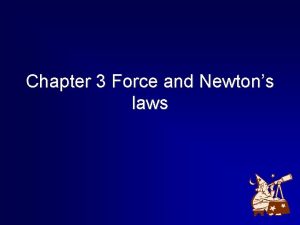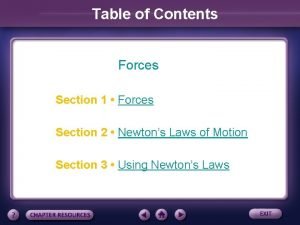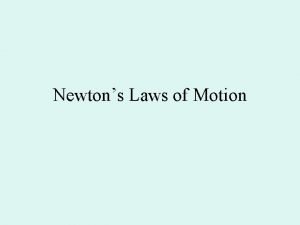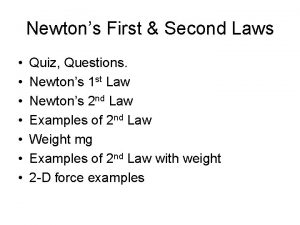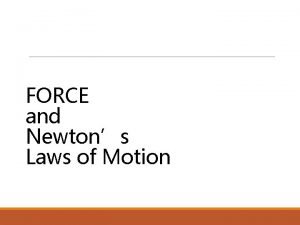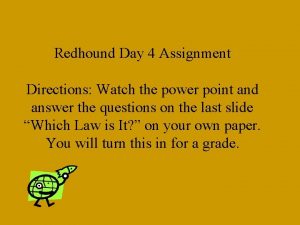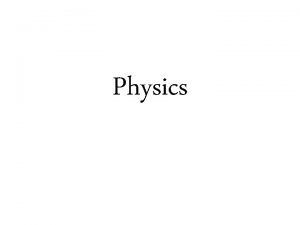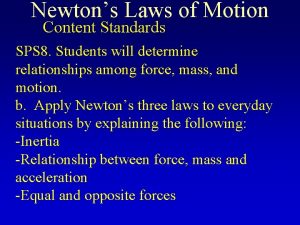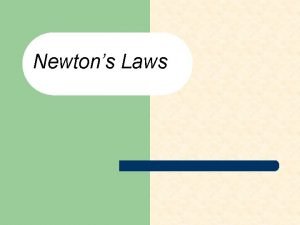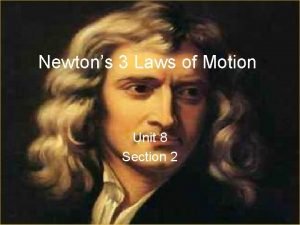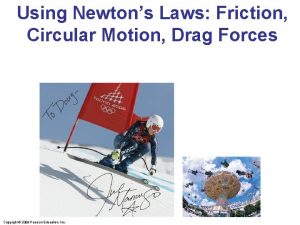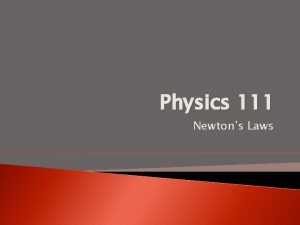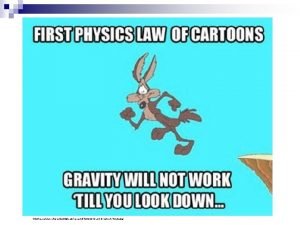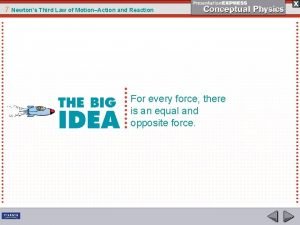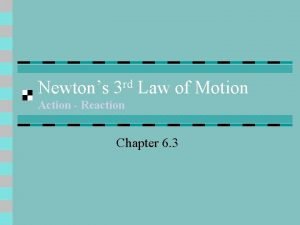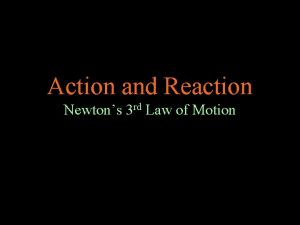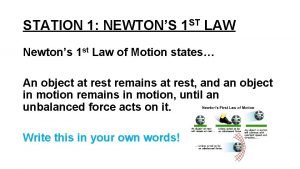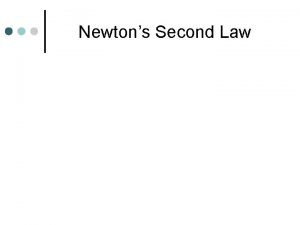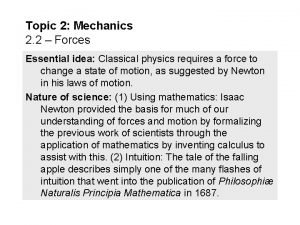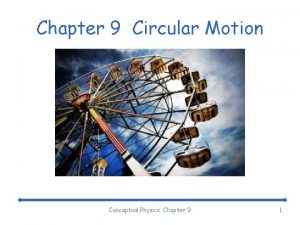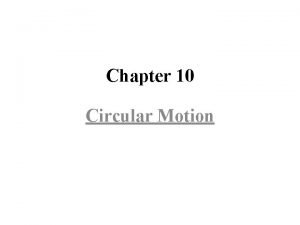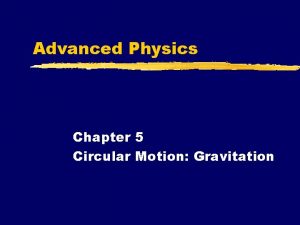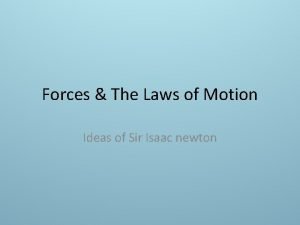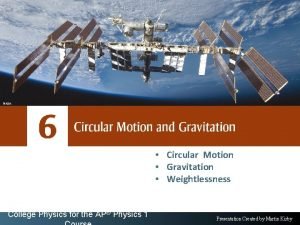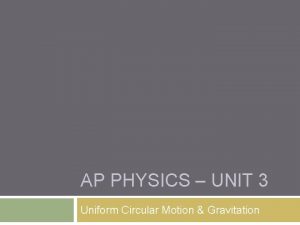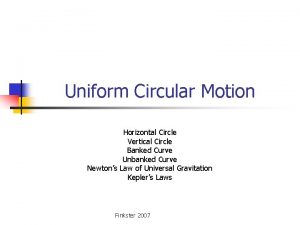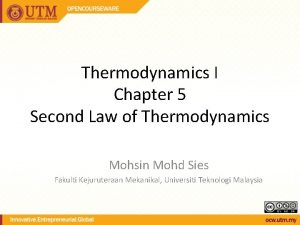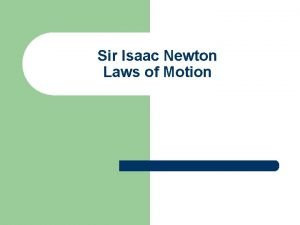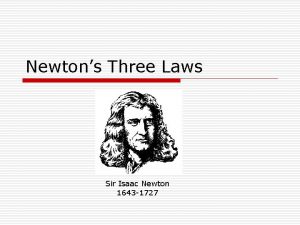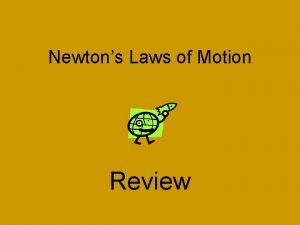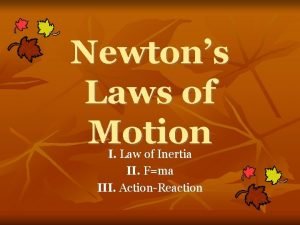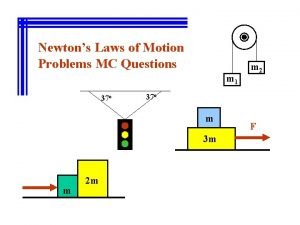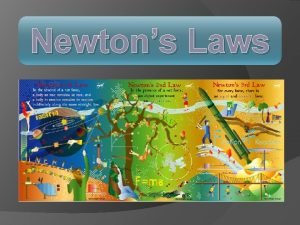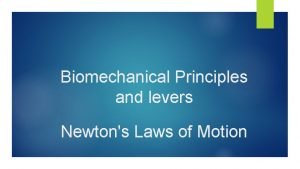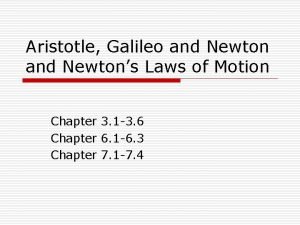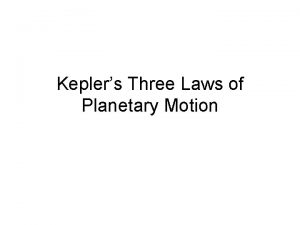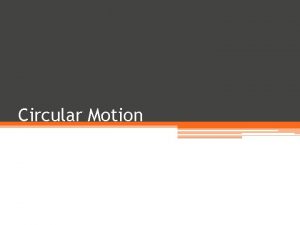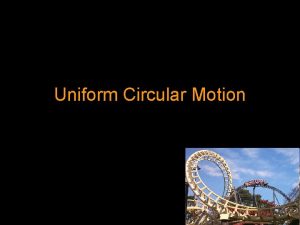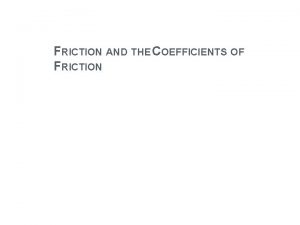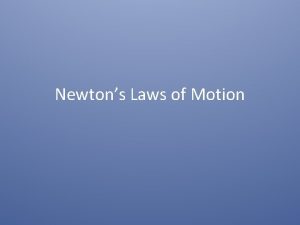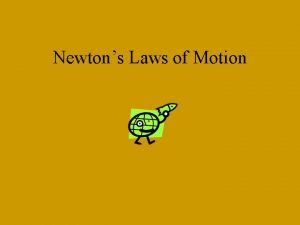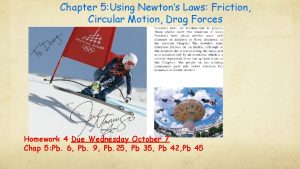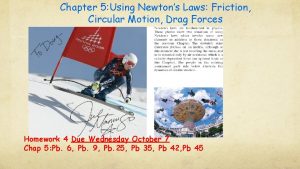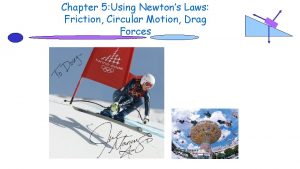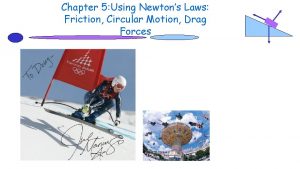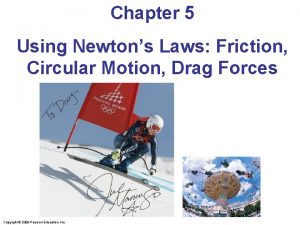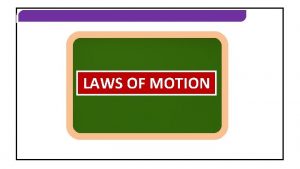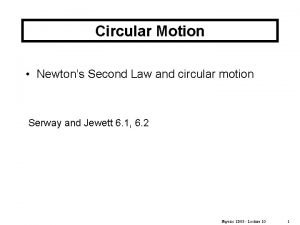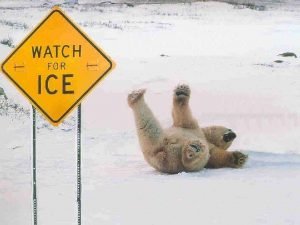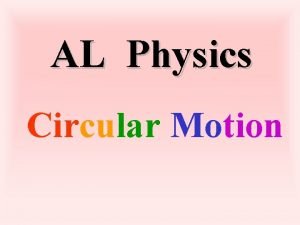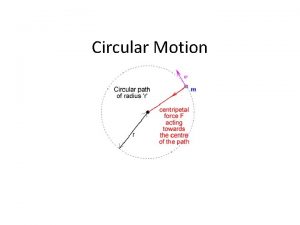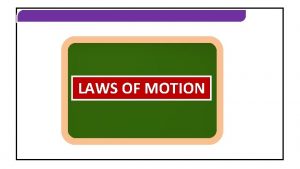Chapter 5 Newtons Laws and Friction Circular motion
































































- Slides: 64

Chapter 5 Newton’s Laws and Friction Circular motion Drag Forces Apparent forces Banking curves

Friction You are standing still, then begin to walk. What was the external forced that caused you to accelerate? Hint: It is very hard to start walking if you are standing on ice. What force causes a car to accelerate when a traffic light turns green?

Frictional Forces Friction is an attractive force between two surfaces that is a result of the vector sum of many electrical forces Between the surface atoms of the two different bodies. Only about 10 -4 of the surface atoms actually contribute. Model of dry friction 3 or 4 asperites support top block. Temporarily weld together Friction is still not well understood The Friction and Lubrication of Solids F. P. Bowden and D. Tabor, Oxford University Press 1964 Models of friction See Chabay and Sherwood Matter and Ineractions Volume 1 ISBN 0 -471 -35491 -0

Note that, in general, μs > μk.

No motion and no horizontal forces What is the free body diagram without friction?

No Motion What is the free body diagram with friction but no motion?

Still No Motion with larger Force F

Increase F more and now you get acceleration Static friction force decreases to kinetic friction and its value remans constant and now you get acceleration

Constant velocity

How is the frictional force related to the normal? Fixed block N mg F fs The maximum value equals is where N is the normal force. Above we would have The coefficient of static friction ranges from 0 to 1. 2 Kinetic Friction: If we increase F until the block starts to move, the friction force decreases to

Problem Solving with Newton’s 2 nd Law involving friction • Vector sum of external forces in x direction = max • Vector sum of external forces in y direction = may • If no acceleration, then set sum equal to 0

. Problem: You have an inclined plane at angle θ with the horizontal with a mass at rest with impending motion. Find the coefficient of static friction μs. 1. Sketch a diagram and label it. 2. Define a coordinate system and origin 3. Write down the forces on your diagram. 4. Draw a free body diagram and resolve the forces into components. 5. Apply F=ma to each axes. 6. Solve for the unknowns. 3/5/2021 Physics 631

. 1. Sketch a diagram and label it. m θ 3/5/2021 d Physics 631 h

. 2. Define a coordinate system and origin +y θ +x m θ 3/5/2021 h d Physics 631

. 3. Write down the forces on your diagram. +y N θ fs θ 3/5/2021 d mg Physics 631 h +x

. 4. Draw a free body diagram for the mass and resolve the forces into components +y N +x θ θ 3/5/2021 mg Physics 631

. 5. Apply Newton's 2 nd law in the x direction +y x direction N +x θ θ 3/5/2021 mg Physics 631

. 5. Apply Newton's 2 nd law in the y direction +y N θ +x θ 3/5/2021 mg Physics 631

. 6. Solve for the unknown 3/5/2021 Physics 631

If the angle is large enough, then the block accelerates. What is a? +y . x direction N +x θ θ 3/5/2021 mg Physics 631

Problem: Find a and T for the Atwood’s machine with friction between M and surface. N +y fk T +x Mg T fk T T T mg -y

Find a and T for the Atwood’s machine with friction between M and surface. N f T Mg T mg -y

Find a and T for the Atwood’s machine with friction between M and surface. fk T

Problem 30 Chap 5 Giancoli

• Box A and box B, each of mass 2. 7 kg, are on a surface inclined at 34° to the horizontal. The coefficient of kinetic friction is 0. 15 and box is moving down. • (a)What is the acceleration of block A? • (b) What is the smallest value of the coefficient of kinetic friction that will keep the box from acceleration.

Question: What is the minimum magnitude force required to start the crate moving? +y N φ Tcosφ fs mg x components T +x y components

Question: What is the initial acceleration if μ k=0. 35? +y N φ fs Tcos φ T +x mg Newton's 2 nd law x components y components

Velocity-Dependent Forces: Drag and Terminal Velocity When an object moves through a fluid, it experiences a drag force that depends on the velocity of the object. For small velocities, the force is approximately proportional to the velocity like in water For higher speeds, the force is approximately proportional to the square of the velocity like in air.

For slow moving objects in a viscous fluid ma If the drag force on a falling object is proportional to its velocity, the object gradually slows until the drag force and the gravitational force are equal. Then it falls with constant velocity, called the terminal velocity.

Drag Force in Water FD=-kv A 1000 kg boat in the water shuts off its engine at 90 km/hr. Find the time required to slow down to 45 km/hr due to a water drag force equal to -70 v, where v is the speed of the boat. Let k = 70 kg/s.


v = 45 km/hr v 0 =90 km/hr k=70 kg/s m=1000 kg

For high speed objects in air For high speed objects moving thru air, (baseball, skydiver, auto) the drag force due to air resistance is Solve for v 0 Stokes-Napier Law

TERMINAL SPEEDS IN AIR Object ` Feather Snowflake BB Mouse Tennis ball Baseball Sky diver Cannonball Speed (m/s) Speed (mph) 0. 4 1 9 13 31 42 60 -120 250 0. 9 2. 2 20 29 66 86 134 -268 560

How to solve this equation? Two ways One way is to use a spread sheet in Exel and discrete coordinates.


What is terminal velocity of a baseball

Use Newtons 2 nd Law Initial component of momentum: Initial force on ball: Using 2 nd Law Find new p

Newtons 2 nd Law

Go to Excel Spread Sheet 631 Website: Lecture 3 Materials

=C 16+(g-(b_1/m_1)*C 16)*delta_t =D 16+1/2*(C 16+C 17)*delta_t



We can also solve the equation to get the velocity as a function of time before it reaches terminal velocity. Let b = 1/2 Cr. A

Solving equation continued

This can be integrated, and fixing the constant of integration by the requirement that the velocity be zero at t = 0 , which is the case for free fall we find: Now show comparison of this solution with numerical integration with Excel.

Calculations differ due to a large delta t. When delta t becomes small enough, the two curves should be indistinguishable.

UNIFORM CIRCULAR MOTION • Centripetal Acceleration: accelerates a body by changing the direction of the body’s velocity without changing the speed. • There must be a force also pointing radially inward to make this motion. • Examples: – – Ball on a string Moon in orbit around the earth: gravitational force A car making a sharp turn: friction A carousel; friction and contact forces • Demo: pushing bowling ball with broom in a circle 48

5 -2 Uniform Circular Motion—Kinematics Uniform circular motion: motion in a circle of constant radius at constant speed Instantaneous velocity is always tangent to the circle.

Dynamics of Uniform Circular Motion For an object to be in uniform circular motion, there must be a net force acting on it. We already know the acceleration, so can immediately write the force:

Dynamics of Uniform Circular Motion We can see that the force must be inward by thinking about a ball on a string. Strings only pull; they never push.

CENTRIPETAL ACCELERATION: . Δv points radially inward 52

CENTRIPETAL ACCELERATION . Triangles are similar 53

Centripetal Acceleration Magnitudes are related by And, due to similar triangles so . Period of the motion 54

What is the magnitude of ac and its direction for a radius of r = 0. 5 m and a period of T= 2 s, 55

QUALITATIVE QUIZ A ball is being whirled around on a string. The string breaks. Which path does the ball take? c b d e a v 56

5 -3 Dynamics of Uniform Circular Motion Example 5 -13: Conical pendulum. A small ball of mass m, suspended by a cord of length l, revolves in a circle of radius r = l sin θ, where θ is the angle the string makes with the vertical. (a) In what direction is the acceleration of the ball, and what causes the acceleration? (b) Calculate the speed and period (time required for one revolution) of the ball in terms of l, θ, g, and m.

Dynamics of Uniform Circular Motion Calculate the speed v Calculate the period

5 -4 Highway Curves: Banked and Unbanked Example 5 -14: Skidding on a curve. A 1000 -kg car rounds a curve on a flat road of radius 50 m at a speed of 15 m/s (54 km/h). Will the car follow the curve, or will it skid? Assume: (a) the pavement is dry and the coefficient of static friction is μs = 0. 60; (b) the pavement is icy and μs = 0. 25.

5 -4 Highway Curves: Banked and Unbanked Banking the curve can help keep cars from skidding. In fact, for every banked curve, there is one speed at which the entire centripetal force is supplied by the horizontal component of the normal force, and no friction is required. This occurs when:

Example 5 -12: Revolving ball (vertical circle) What is tension at the top of the arc? Let T=FT 1. A 0. 150 -kg ball on the end of a 1. 10 -m -long cord (negligible mass) is swung in a vertical circle. (a) Determine the minimum speed the ball must have at the top of its arc so that the ball continues moving in a circle. Down is negative, Up is positive

Example 5 -12: Revolving ball (vertical circle). What is tension at the bottom of the arc? Let T=F T 2 (b) Calculate the tension in the cord at the bottom of the arc, assuming the ball is moving at twice the speed of part (a). Down is negative, Up is positive

Example of fictitious force In a vertically accelerated reference frame, eg. an elevator, what is your apparent weight? Apparent weight = N Upwards is positive Downwards is negative Upward acceleration Downward acceleration

VERTICAL CIRCULAR MOTION Down is negative, Up is positive At the top: N N r Minimum v for N = 0: (apparent weightlessness) At the bottom:
 Newtons laws od motion
Newtons laws od motion What are newtons 3 laws
What are newtons 3 laws Newton three law of motion
Newton three law of motion What are the newton's laws of motion
What are the newton's laws of motion Does friction cause heat
Does friction cause heat Newton's law
Newton's law Problem 3
Problem 3 Newton's third law rockets
Newton's third law rockets Third law of newton
Third law of newton Section 3 using newton's laws
Section 3 using newton's laws Section 3 using newtons laws
Section 3 using newtons laws Elevator bank
Elevator bank Newton's st law
Newton's st law Newtons 3 laws quiz
Newtons 3 laws quiz Newtons laws definitions
Newtons laws definitions Newton's three laws
Newton's three laws What is newtons law
What is newtons law Newton's 3rd law
Newton's 3rd law Examples of law of inertia
Examples of law of inertia Newtons laws
Newtons laws Newton's 3 law of motion
Newton's 3 law of motion Newton's first law of motion examples
Newton's first law of motion examples Newtons laws
Newtons laws Ethan is dragging a bag of grass
Ethan is dragging a bag of grass Newtons 3 rd law of motion
Newtons 3 rd law of motion Newtons 3 rd law of motion
Newtons 3 rd law of motion Newton’s 3rd law
Newton’s 3rd law Newtons 3 rd law of motion
Newtons 3 rd law of motion Newton's second law meme
Newton's second law meme Newtons third law
Newtons third law Newton's 3 laws of motion
Newton's 3 laws of motion Newtons 3 rd law of motion
Newtons 3 rd law of motion Newtons 3 rd law of motion
Newtons 3 rd law of motion What is one newton
What is one newton 2nd law of motion
2nd law of motion Newton's 2nd law of motion examples
Newton's 2nd law of motion examples Brainpop newton's laws of motion worksheet answer key
Brainpop newton's laws of motion worksheet answer key Law of dry friction
Law of dry friction Laws of friction
Laws of friction Laws of friction class 11
Laws of friction class 11 Circular motion conceptual physics
Circular motion conceptual physics Chapter 10 circular motion
Chapter 10 circular motion Chapter 5 circular motion gravitation
Chapter 5 circular motion gravitation Useless laws weaken the necessary laws
Useless laws weaken the necessary laws Forces and the laws of motion problem b
Forces and the laws of motion problem b Create length and height in hair design
Create length and height in hair design Chapter 2 section 1 describing motion answer key
Chapter 2 section 1 describing motion answer key The main difference between speed and velocity involves
The main difference between speed and velocity involves Chapter 2 section 1 describing motion answer key
Chapter 2 section 1 describing motion answer key Ap physics 1 circular motion and gravitation
Ap physics 1 circular motion and gravitation Ap physics unit 3 circular motion and gravitation
Ap physics unit 3 circular motion and gravitation Circular motion
Circular motion Perpetual motion machine
Perpetual motion machine Isaac newton's laws
Isaac newton's laws Teacher rice edu sir isaac newton
Teacher rice edu sir isaac newton What are the 3 laws of motion
What are the 3 laws of motion 3 laws of motion by isaac newton
3 laws of motion by isaac newton The bird flying gracefully through the air
The bird flying gracefully through the air P = mv formula
P = mv formula Aristotle laws of motion
Aristotle laws of motion A stack of books rests on a level frictionless surface
A stack of books rests on a level frictionless surface Who formulated the three laws of motion
Who formulated the three laws of motion Newton's law of motion biomechanics
Newton's law of motion biomechanics Aristotle galileo and newton
Aristotle galileo and newton 3 laws of planetary motion
3 laws of planetary motion









